Greenham Festival @ Green Gate July 4th 1982
In 1982 loose plans were made for a Green Gathering at USAF Greenham Common, the proposed site for nuclear-armed Cruise missiles. It quickly became apparent, however, that there was insufficient time and energy to organise it, as well as the larger green gathering that was planned for Worthy Farm, near Glastonbury. Thus was the idea born for a free ‘bring what you expect to find’ Greenham Festival instead.The start date was set for the Fourth of July, Independence Day, to make the point that it was the UK that was now occupied by large numbers of US military bases. It was agreed there would be no advertised finish date, in the hope that a permanent settlement might be established under cover of the festival.
The previous year a group of women had marched from Wales to Greenham and a women’s camp had been established at the main gate since September 1981. The idea was to support and extend the campaign by establishing an additional, this time ‘mixed’, camp.
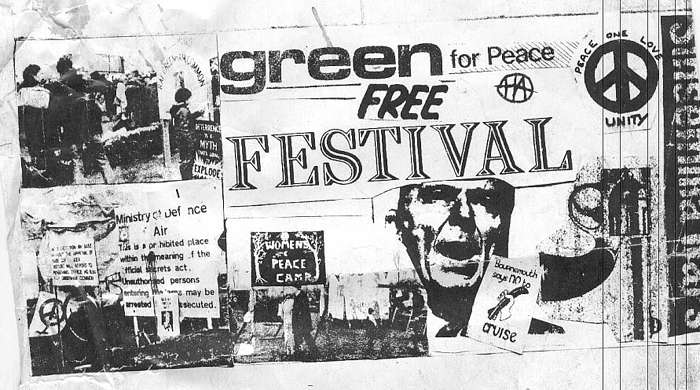 The location was the Works entrance, where Fran De’Ath had held a personal vigil until May, sleeping in a tipi and providing cups of tea to the workers.
The location was the Works entrance, where Fran De’Ath had held a personal vigil until May, sleeping in a tipi and providing cups of tea to the workers.
She describes how the Greenham Common peace camp had offered to help fund the gathering There was some £15,000 in the account according to Fran, who was one of the signatories. However, while she was away, representing peace camps at a UN conference in Geneva, Helen Johns, described by the bank as the camp’s ‘leader’ and who was opposed to the gathering, went to the bank and had her and Caroline Taylor removed as signatories. As Fran says “we don’t know what happened to the money after that”.. Fran left Greenham a short while later.
The Works Entrance had recently been labelled the ‘green’ gate. 1982 was the year the word 'green' was first used in the UK to describe a new broad political movement that was emerging, and which embraced, in a broad informal coalition, the new social movements which had been growing since the 1960s (ecology, feminism, peace, alternative technology, animal rights, social justice de-centralisation etc) in a grassroots coming together.
What was planned as a small event changed dramatically with the arrival of a 'peace convoy' from Stonehenge Festival to USAF Greenham Common.
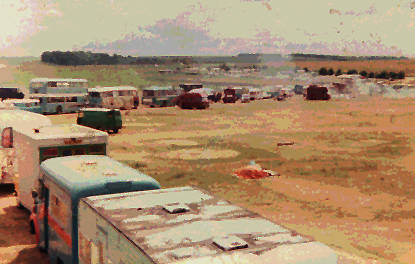
For a number of years the end of June had been the time when a convoy(s) of free festival travellers left Stonehenge, after a month of being there, and headed out around the country for the festival circuit. It had been termed 'the' convoy.
This was the context in which various folk, in 1982, spread the word that this year the convoy would be going to Greenham Common US airbase, the first proposed site for the deployment of what was called 'first strike' Cruise missiles. Because it was believed that these new missiles could destroy the Soviet Union before they could launch their own it marked a major shift from the Mutually Assured Destruction (MAD) nuclear doctrine that existed before.
Brig Oubridge, Ecology Party member and one of those at Stonehenge who encouraged the convoy to Greenham, describes it as follows:-
“The Spring Equinox event attracted a lot of festival/Green Gathering types who were then also at Stonehenge for midsummer, and it was they who spread the idea of a ‘Peace Convoy’ from there to Greenham. Yes, I was one of them, but it takes a lot more than one person to spread an idea among thousands, and it wouldn’t have taken off if it did not accord with the zeitgeist and general desire to support the women in what they were doing.”
Amongst those spreading the idea was Andy Hope, later of the Green Roadshow, and Tony Cordy, of the Tibetan Ukrainian Mountain Troupe, Britain's surreal answer to America's Merry Pranksters, who were touring festivals in a collection of psychedelically painted old buses. In Tony’s memory: “I’m almost entirely responsible for the peace convoy”
He describes, firstly, how Magpie John, a scrap yard owner on the edge of Inglestone Common in Gloucestershire came to see him in his bus at Stonehenge to ask the convoy not to go to Inglestone. In recent years it had been the convoy’s regular destination at the end of June and the convoy had been cited as the cause of much angst amongst locals.
The second reason was another visit to his bus, this time by a woman he describes as ‘hooded’ and ‘secretive’. She was one of two sisters (possibly twins), who said they were living at the Greenham Common women’s peace camp at the time. They were concerned that the women-only approach was ‘going too far’; that the number of women at the camp was dangerously low and that the camp was at risk of failing. She said the camp was pretending there were more women than there actually were. This woman came to ask the convoy to go to Greenham.
Looking back Fran De’Ath suspects this visitor may have been an agent provocateur and strongly disagrees with the idea that numbers were down at the women’s peace camp.
To reinforce the plan a stencil with the words 'peace convoy' was cut (possibly by Bender Dave..) and used to emblazen the sides of trucks and buses, and people's jackets. The idea was simple; to build momentum behind the idea that this year the convoy would be going to a free festival at USAF Greenham Common, which had now been re-named the ‘Cosmic Counter Cruise Carnival’. It is worth remembering that there was a popular song in the mid-70s, called ‘Convoy’ by CW McCall which featured truckers using CB radio, as did many UK travellers. This is how the ‘peace convoy’ concept was born.
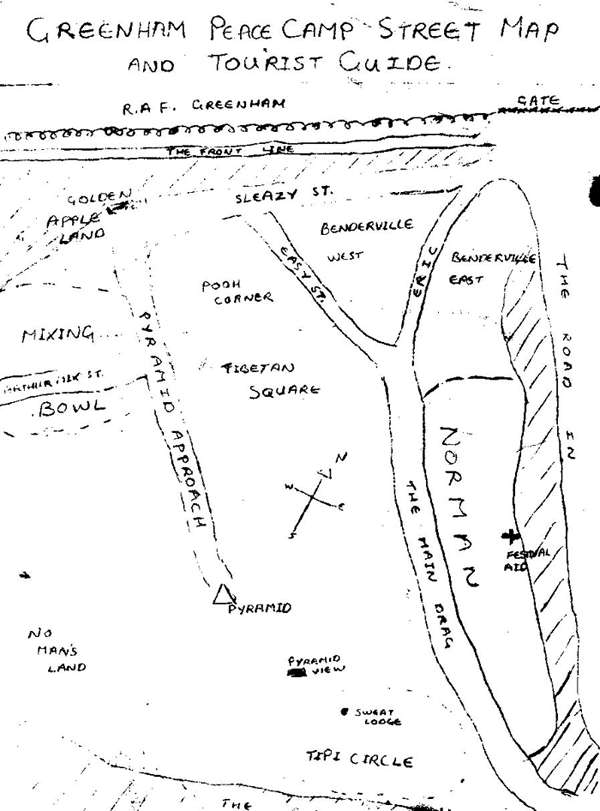 Thus it was that a convoy of 130 vehicles, led by Gypsy Dave in his Jaguar, arrived at Greenham on June 30th with about 500 people on board. They took the site and formed the core of the festival that followed.
Thus it was that a convoy of 130 vehicles, led by Gypsy Dave in his Jaguar, arrived at Greenham on June 30th with about 500 people on board. They took the site and formed the core of the festival that followed.
It should be said that from the beginning of the 1980s, with unemployment rapidly rising, Stonehenge Free Festival had grown substantially and become quite a wild place. The sudden growth, from around 7000 to 20,000+ happened in 1980, on the weekend of the solstice. That growth took everyone by surprise. As Brig says: - “the previous informal ‘non-organisation’ network suddenly had more than it could comfortably handle”.
After 1980 Wiltshire police’s laid-back hands-off approach also changed. “They were as taken aback by the mushrooming of it as anyone else, and thereafter attempted a more pro-active stance, which was then resisted to the extent that police entering the site would be followed around by a large jeering crowd and made to feel uncomfortable.”
Stonehenge Free Festival attracted thousands of people and by the end of June many felt quite distant from, and unbound by, the normal conventions of society. And so the scene was set for a festival with a difference...
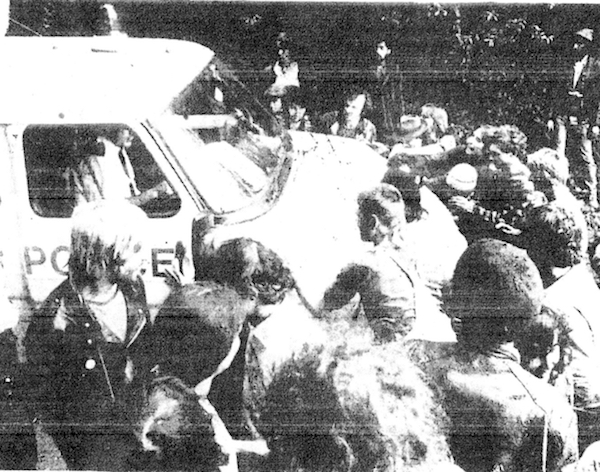 On the way to Greenham the police attempted, without success, to direct the peace convoy the wrong way off a roundabout and then, on arrival at Greenham, the convoy found Newbury District Council had dug trenches across the entrance to the site -officially the Works Entrance- and the police were there blocking the way with a van. This was swiftly dealt with. With the numbers of people available and with plenty of whooping, the van, with policemen inside, was easily ‘levitated’ out of the way and the trenches backfilled -the council having left the earth conveniently dumped nearby. The site was taken.
On the way to Greenham the police attempted, without success, to direct the peace convoy the wrong way off a roundabout and then, on arrival at Greenham, the convoy found Newbury District Council had dug trenches across the entrance to the site -officially the Works Entrance- and the police were there blocking the way with a van. This was swiftly dealt with. With the numbers of people available and with plenty of whooping, the van, with policemen inside, was easily ‘levitated’ out of the way and the trenches backfilled -the council having left the earth conveniently dumped nearby. The site was taken.
Fran, who had very good relations with the police, remembers the buses and trucks lined up along the road waiting to get in, and being asked to mediate with the convoy. Wisely she declined the invitation:
“Without a leader or accepted representative there was really no one to negotiate with.”
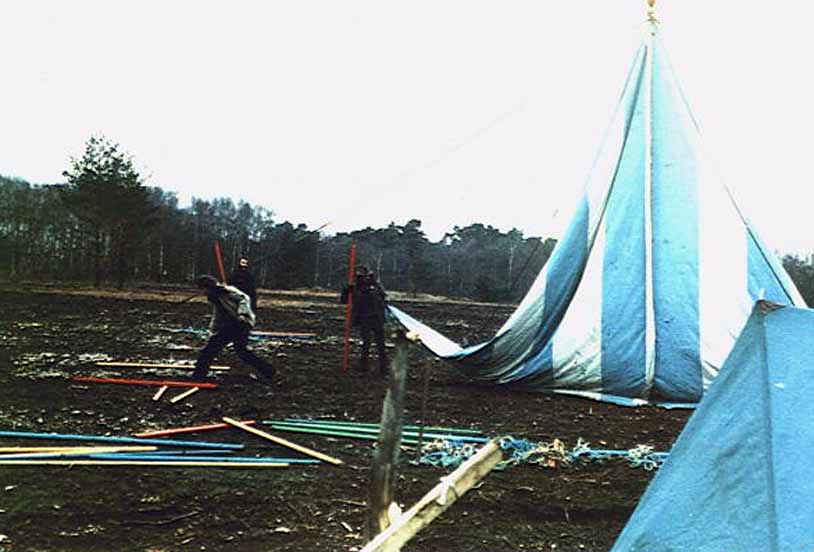
The local council decided, despite howls of local opposition, that it wouldn't take immediate action (which would have been legally long-winded in any case) and would wait for the festival to come to an end. Some activists, however, hoped they could persuade enough people to stay on to form a permanent peace settlement.
Green CND, which had been formed as Ecology Party CND at the previous year's Green Gathering, and was involved in plans for the festival, had been active around Greenham Common that summer and had named the Works Entrance Green Gate, largely because of the woodland that surrounded it but also because the large open space in front of the entrance had already been identified as suitable for camps and a green gathering.
When I visited the site I stayed in the back of Brig Oubridge's truck, from where he published the Greenham Free Press, also called ‘Crews News’, a news sheet that kept everyone on site in touch with what was going on. This space was also designated Green CND's on-site office. Green CND, with newly acquired specialist section status, was the one part of CND that had contact with elements of the traveller community, largely through relationships established at the green gatherings.
 Most of the Campaign for Nuclear Disarmament, however, were from more conventional backgrounds and viewed what was going on with suspicion. On July 3rd members of the settlement travelled up to London to address CND's national officers. The executive gave notional support but no funds or practical help.
Most of the Campaign for Nuclear Disarmament, however, were from more conventional backgrounds and viewed what was going on with suspicion. On July 3rd members of the settlement travelled up to London to address CND's national officers. The executive gave notional support but no funds or practical help.
 It was from Brig's truck, the next day, on July 4th, that the Declaration of Independence of the People's Peace Settlement at Greenham was published. Written as a pastiche of the original US Declaration of Independence it decried the occupation of 'the countries of Britain' "by the armed forces of a foreign power, the United States of America. An occupation for which the consent of the British people has never been sought or given." It concluded with the rousing declaration that "we are left with no alternative but to throw off the power of both these governments (USA & UK) and to declare here at Greenham Common THE PEOPLES FREE STATE OF GREENHAM" and an invitation to 'all people who care for peace, freedom and the continuance of life to rally here in peace to oppose the forces of death and destruction.'
It was from Brig's truck, the next day, on July 4th, that the Declaration of Independence of the People's Peace Settlement at Greenham was published. Written as a pastiche of the original US Declaration of Independence it decried the occupation of 'the countries of Britain' "by the armed forces of a foreign power, the United States of America. An occupation for which the consent of the British people has never been sought or given." It concluded with the rousing declaration that "we are left with no alternative but to throw off the power of both these governments (USA & UK) and to declare here at Greenham Common THE PEOPLES FREE STATE OF GREENHAM" and an invitation to 'all people who care for peace, freedom and the continuance of life to rally here in peace to oppose the forces of death and destruction.'

Soon after this there was a full moon and total lunar eclipse, when the moon was due to pass through the centre of the Earth's shadow -obviously a good moment to throw a party.. A stage was erected, supplies brought in and word sent out. The moment I most remember was dawn the next morning. After a night of wildness and as the sun rose, with the moon still up, the Sisters of Mu, a powerful female hard rock band, blasted the base at top volume. It was more than enough to send a tremor of excitement up my 24 year old spine. Anything was possible. We would win this campaign...
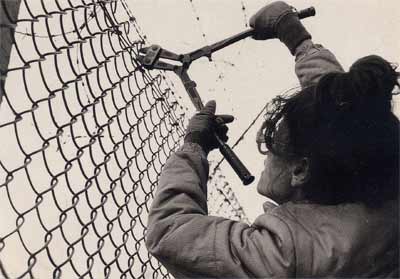

It was during this night that Tony Cordy and Gyp decided to “up the ante”, cut a small hole in the fence and imaginatively 'decorate' some of the construction vehicles.
The next morning the MOD police over-reacted, rushing in mobile searchlights and bulldozers, and tearing down about an acre of trees on the inside of the fence. It was this revengeful act against trees that then provoked some folk to take sledgehammers to the reinforced concrete fence posts surrounding the base (which they found would come down easily with three good hits) and demolish some 65 of them, bringing down the gate and a substantial section of the perimeter fence.
The only person identified as being responsible for this action was Kevin Hutton of the tipi community in Wales, who later received eight months for the ‘offence’. Others rumoured to have taken part included members of the Tibetan Ukrainian Mountain Troupe (TUMT), Britain's surreal answer to America's Merry Pranksters, who were touring festivals in a collection of psychedelically painted old buses.

For many years we had debated whether physical damage to property should be seen as 'violent' and whether we, as a nonviolent movement, should eschew such tactics. This action, however, was spontaneous and was undertaken in response to the MOD's eco-vandalism. Whether the action broke a taboo will be debated but from this point on holes in the fence, damage, decoration of the fence and incursions into the base became common features of the campaign.
The next day, on the 9th, six people were arrested for the action, and a seventh for obstruction, in a heavy-handed raid by some 400 police. This was resisted non-violently with everyone staging a sit-down or climbing trees. The police claimed they had photographic evidence, but only one of those arrested had openly admitted taking part in the action. The ‘guilt’ or otherwise of the others was not clear. The police also confiscated the TUMT’s generator (although this was later returned) as a response to the party.
On Monday July 12th those arrested appeared in Newbury Magistrates Court where six were remanded in custody and the one charged with obstruction conditionally discharged. The 'Greenham Seven' then became the object of a support campaign, organised by Brig, to raise funds for legal costs and fines.
On Friday 16th the Seven (with the addition of a separate criminal damage case) again appeared in court. Three were given bail immediately and four got it after an appeal by Lord Gifford QC. At the Green Gathering later that month the support campaign raised money, via the newsheet Green Hum, to cover anticipated fines.
All seven later appeared in court, synchronistically on Hiroshima Day August 6th, where they were fined and released.
 The whole episode apparently quite spooked the US Embassy who complained to CND that they were being attacked with petrol bombs (totally untrue) and bows and arrows!.. Did the tipis remind them of something?.. Rather predictably, however, CND responded that the action had nothing to do with them. Joan Ruddock, chair of CND, was quoted in Radiator magazine as saying that 'the position of CND is now not so clear because of the events occurring since our last meeting.'
The whole episode apparently quite spooked the US Embassy who complained to CND that they were being attacked with petrol bombs (totally untrue) and bows and arrows!.. Did the tipis remind them of something?.. Rather predictably, however, CND responded that the action had nothing to do with them. Joan Ruddock, chair of CND, was quoted in Radiator magazine as saying that 'the position of CND is now not so clear because of the events occurring since our last meeting.'
One peace settler, quoted in the Radiator, said he 'found it appalling that no one CND representative has come to this site to see and feel what is really going on here. Disappointment hardly seems the appropriate word to describe my feelings...'
July 18th was the day the convoy moved on, with other festivals beckoning. Around 150 people remained but dreams of a permanent settlement were fading.
It was also the day when the News of the World (circulation 4 million plus) published its notorious 'Sex and Drugs at the Peace Camp' story - interestingly the only national media outlet to report at all on what was happening.The Greenham Festival had a few signs openly advertising illegal drugs, in a way that was actually quite usual at free festivals at the time. It was, however, also a gift to anyone who wanted to smear the festival/peace movement. On cue the NoW reporter appeared. His report was a masterpiece of fabrication, with a doctored photo showing more drug signs than there actually were, and beginning with a statement that 'Anything goes at a sex and drugs hippy colony' and 'in the evening there are orgies round the campfire'. In calling the ‘festival’ a ‘peace camp’ the paper was trying to smear all peace camps in the same way tabloids later called all new age travellers a ‘peace convoy’ in an attempt, by implication, to smear the peace movement as a whole.
 Alternating mud and dust, compounded by a lack of external support and the lure of the Green Gathering saw the rest drift away during the following week and by the 26th there were just ten people left. They too soon left. Over at the Green Gathering Brig was publishing the last editions of the Greenham Free Press and raising funds for the Greenham Seven fines. Greenham Festival had ended and hopes of a permanent settlement postponed for another day.
Alternating mud and dust, compounded by a lack of external support and the lure of the Green Gathering saw the rest drift away during the following week and by the 26th there were just ten people left. They too soon left. Over at the Green Gathering Brig was publishing the last editions of the Greenham Free Press and raising funds for the Greenham Seven fines. Greenham Festival had ended and hopes of a permanent settlement postponed for another day.
For the vast majority of those who came from Stonehenge the Counter Cruise Cosmic Carnival was, as Brig says, “never going to be anything other than a passing stop on the annual d-i-y free festival circuit as an alternative to the previous favourite of Inglestone Common.” For many of the women at the main gate camp however, the festival, or the controversy it brought, was counter-productive.
For Green activists Greenham Festival was an invaluable dry run for the occupation of USAF Molesworth, the second Cruise missile base, two years later. All the same ingredients were there; a squatted site, travellers taking the site, the attempt to create a permanent settlement, nonviolent direct action, media silence, a smear campaign and CND ambivalence.
The difference, of course, was that by the time we got to Molesworth we knew what we were doing and were successful in our goal of opening a new front in the campaign and creating a massive eviction that led the news across all media, generated a debate in Parliament and embarrassed the Defence Secretary, Michael Hesseltine.
In hindsight Brig’s view was “that the demolition of the fence was extremely controversial within the peace movement, and that that, together with the generally unconstrained behaviour of many elements of the convoy, was instrumental in reinforcing the determination of a majority of the Greenham Women to keep the protests there strictly all women. It was an action conceived in a spirit of solidarity whose effects were almost entirely divisive.”
The divisive effect was undoubtedly true but when one looks at the bigger picture it’s clear that the Cosmic Counter Cruise Carnival had a positive effect as well. It led directly to the opening of a second front in the campaign against Cruise, the occupation at Molesworth. This was conceived partly because men needed somewhere else to campaign, but also because we knew the campaign had to spread. The US government needed to see that opposition wasn’t limited to Greenham.
Bruce Garrard, editor of the Radiator magazine, also commented that the Greenham Festival “helped change attitudes to ‘damage to property’ – at least when that property is MoD fences around nuclear bases . “
“The only thing I can remember personally is turning up one day and the first person I saw was you by the fire outside the sweat lodge bender shouting ‘sweat lodge’ at the top of your voice, so I took my kit off and came for a sweat, only to discover that it was already over!”
Ultimately, of course, nuclear-armed Cruise deployment was stopped and the Cold War came to an end. The campaign as a whole was successful.
Chris Waite shot material at Stonehenge and the Greenham Festival in 1982 using an 8mm film camera. You can see his video here on Vimeo. The convoy departure from Stonehenge starts around 2 mins in and the Greenham segment is from about 4:30 including shots of the demolished fence.
